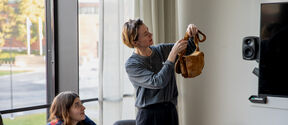Design for government

Doctoral researcher Seungho Lee sees the world through the eyes of a designer. Originally from South-Korea, Lee first came to Helsinki in 2008 to work as a design consultant. In Finland he became fascinated by the pioneering design research at Aalto, as well as the Finnish Innovation Fund Sitra’s holistic approach to design. Fairly soon, Lee started working for a Sitra-powered initiative, Helsinki Design Lab.
“This is where the idea of applying design thinking to policy making really hit me,” Lee reminisces. He retells a story he often heard at Sitra:
A public swimming hall had clearly become very unpopular. Customer rates were down. City officials knew the building was getting old, so they asked an architect to design them a new swimming hall. She agreed, but after a few weeks she returned and said: ‘A new swimming hall won’t solve your problem. Last year, you changed the bus schedules abruptly. Getting to the hall is now highly inconvenient for everyone using public transportation. That’s why your customers vanished’.
“It’s a fictitious tale that opens up the potential of design thinking for policy makers,” Lee smiles. “We should never assume we know the cause of a problem. A holistic user’s perspective is a fruitful approach for every design.”
Working directly with ministries
The course Design for Government (DfG) has been a tremendous hit ever since it started in 2013.
“We developed it together with the course teachers Hella Hernberg and Juha Kronqvist. Today, the 14-week course is arranged every spring as a part of the Master’s degree in Creative Sustainability, and we have Professor Ramia Mazé as our leader. Students come from fields such as design, business, engineering and social sciences,” says Lee.
“What makes DfG unique is the fact that our students work directly with ministries and relevant stakeholders to provide them with experimental research. The course has two to three different ministries as the commissioner each year.”
DfG students have worked with for example the Ministry of the Environment and the Ministry of Forestry and Agriculture, looking into themes such as accessibility of buildings, reducing the use of plastic bags, preventing waste by extending the lifecycle of electronic products, and finding ways to advance fruit and vegetable consumption among school children.
Proposing a new model for the Prime Minister’s Office
In 2014, the Finnish Prime Minister’s Office announced a tender looking for ways to advance behavioral and experimental research to support governmental policy making.
The winning proposal came from think tanks Demos Helsinki and Avanto, with Aalto’s DFG course as a partner. The project consisted of two stages: establishing a global benchmark of best practices, and an experiment arranged as a part of the DFG course in 2015, with students attempting to solve concrete challenges faced by the government. Fittingly, the project was also named Design for Government.
“The DFG Project examined, among other issues, how the DFG course’s unique approach could be operationalized in the Finnish Government. This was a truly exceptional opportunity for our students to take part in potentially policy shaping research,” Lee confirms.
The project report proposed a new, quick-to-implement model for including experiments and behavioral approaches into Finnish policy design: humancentric governance through experiments.
Experimental Finland
One of Finland’s current government’s key projects is to promote an experimental culture. The aim is to find innovative ways to develop society and services.
“We are advocating an experimental culture on a national level,” explains Dr. Kaisa Lähteenmäki-Smith, Science Specialist, Prime Minister’s Office.
“The DFG Project that students successfully contributed to was in a way a starting point for us to take action from the PMO level. The project provided holistic knowledge of possibilities, and ideas on how hands-on behavioral approaches could make policy more user-oriented, targeted and efficient,” Lähteenmäki-Smith affirms.
“One of the key notions we understood during the DFG Project was that we must be able to offer decision makers information from grass root experiments. We have thus far focused on evidence based decision making: what works? While this remains extremely important, we also need user based decision making: what makes people tick?”
Lähteenmäki-Smith mentions a DFG student design team’s work as an example: “Finnish farmers have to fill out a great deal of forms to receive subsidies. Students tackled the issue from the farmer’s perspective and came up with ways to make the process far more user friendly and effective – and also make public officials accountable for the forms they create through feedback.”
While Lähteenmäki-Smith is highly enthusiastic of the prospects of an experimental culture, she underlines that Finland is not as advanced in utilizing behavioral insights in policy making as peers around the globe often presume.
“When I am asked what my vision is of Finland’s experimental culture, I often jest that I hope to see us where people think we already are,” says Lähteenmäki-Smith. “But while we are not as far as some suppose, we are every bit as brave as we have been given credit for internationally. We are now boldly advancing an experimental culture – one of the first major initiatives to be implemented is a basic income experiment.”
Building a common future
Ramia Mazé is the course leader of the Design for Government course. As Professor of New Frontiers in Design, she pursues a programmatic vision in ‘Designing our common future’: “As a researcher, educator and designer, I specialise in critical and participatory approaches to design for systems and products that alter social practices and public life. While design is traditionally formulated in relation to industry, this work explores the expansion of design roles in society.”
Prior to her professorship at Aalto, Ramia Mazé worked in Sweden at Konstfack University College and the KTH Royal Institute of Technology. She has led several interdisciplinary and international research projects and worked as a professional designer in the EU and US.
Professor Mazé encourages both the potential collaboration partners and Aalto students to take part in this course: “If you are a civil servant interested in applying design to policy making or a student interested in designing for the public sector, please see our website and contact us.”
This article is originally published in the Aalto University Magazine 18 (issuu.com).
Read more news

From award-winning food packaging to researching biodesign spaces
From an early age, Ena Naito was drawn to both the sciences and design. She found the perfect place to bring those two worlds together.
See Me Make, Make Me See
A Nordic Exploration of Craft, Observation and Language
ARTEFAKTI25
ARTEFAKTI returns for the third year at Helsinki Design Week






